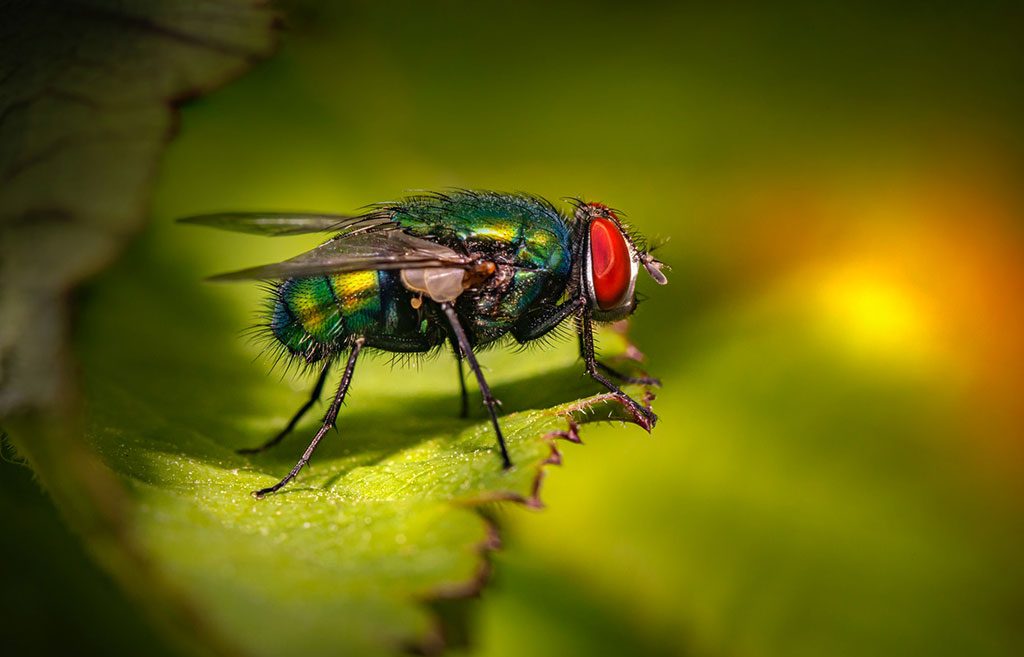Researchers at the School of Science at IUPUI have found that blow flies can be used as chemical sensors, with a particular focus on the detection of chemical warfare agents.
Despite widespread bans, chemical weapons have been deployed in recent conflicts such as the Syrian civil war, and some experts fear they may be used in the war in Ukraine. An IUPUI study shows that blow flies could be used as a safer alternative for investigating the use of these weapons — as well as other chemicals in the environment — keeping humans out of potentially dangerous situations.
The research was funded through a contract from the U.S. Defense Advanced Research Projects Agency (DARPA).
“Blow flies are ubiquitous, and they are very adept at sampling the environment around us,” said Christine Picard, an associate professor of biology and director of the Forensic and Investigative Sciences Program in the School of Science at IUPUI. “They will fly through the environment, taste it, and that information will be stored in their guts. Through a series of experiments, we were able to look at how different environmental factors would impact their detection of chemical weapon simulants.”
“We used a mass spectrometer to determine what chemicals were in the blow flies’ guts,” Manicke said. “We were able to detect the chemical warfare agent simulants, and also some of the things chemical agents get broken down into once they’re in the environment. If a fly were to come across a water source, with a chemical agent hydrolyzed in the water, we would find that in the fly.”
While chemical warfare agents do not persist for long in the environment, the researchers found they’re preserved well enough in the fly’s guts for chemical analysis. They also were able to detect the chemical warfare agent simulants up to 14 days after a fly’s initial exposure — illustrating a safer alternative for the collection of samples, without risking human lives.
“If an area is too dangerous, too remote or in an access-restricted area — or if one just wanted to collect samples covertly — then one just needs to put out some bait and the flies will come to the bait,” Manicke said. “We can scan through big areas by drawing the flies into a trap and analyzing what is in their guts.”
This research also has important applications for environmental scientists who want to understand how pollutants, such as pesticides, move through the environment.
“Due to the collaboration between Dr. Manicke and Dr. Picard, we were able to work on a project with the potential to make a direct impact,” said Sarah Dowling, a Ph.D. student who co-authored the study. “It is fulfilling to know that the work we did throughout this project could improve the safety of warfighters and others who deal with chemicals in the environment.”
The team of students who conducted the experiments using a chemical weapon simulant were led by Nick Manicke, an associate professor of chemistry and chemical biology and of forensic and investigative sciences at IUPUI. A chemical weapon simulant shares features of actual chemical warfare agents — but is not poisonous to people — as well as pesticides, which are chemically similar to chemical warfare agents in the terms of their molecules’ behavior.
Next, the researchers plan to apply what they learned from this study toward a new two-year project funded by the Army Research Office on Environmental Chemistry. This work will focus on the detection of molecules from “insensitive munitions,” which are a new type of explosive compounds that are less likely to detonate by accident. Because of this, however, they tend to deposit more in the environment.
Using blow flies from areas that are remote or dangerous, Manicke and Picard will look for traces of insensitive munition compounds in the flies, indicating environmental contamination.
Insects as Chemical Sensors: Detection of Chemical Warfare Agent Simulants and Hydrolysis Products in the Blow Fly Using LC-MS/MS. Environmental Science and Technology, 21 September 2022. (subscription required)
In this work, blow flies were investigated as environmental chemical sample collectors following a chemical warfare attack (CWA). Blow flies sample the environment as they search for water and food sources and can be trapped from kilometers away using baited traps. Three species of blow flies were exposed to CWA simulants to determine the persistence of these compounds under varying environmental conditions. A liquid chromatography mass spectrometry (LC-MS/MS) method was developed to detect CWA simulants and hydrolysis products from fly guts. Flies were exposed to the CWA simulants dimethyl methylphosphonate and diethyl phosphoramidate as well as the pesticide dichlorvos, followed by treatment-dependent temperature and humidity conditions. Flies were sacrificed at intervals within a 14 day postexposure period and analyzed with the LC-MS/MS method. The amount of CWA simulant decreased with time following exposure but were detectable 14 days following exposure, giving a long window of detectability. In addition to the analysis of CWA simulants, isopropyl methylphosphonic acid, the hydrolysis product of sarin, was also detected in blow flies 14 days post exposure. This work demonstrates the potential to obtain valuable samples from remote or access-restricted areas without risking lives.


